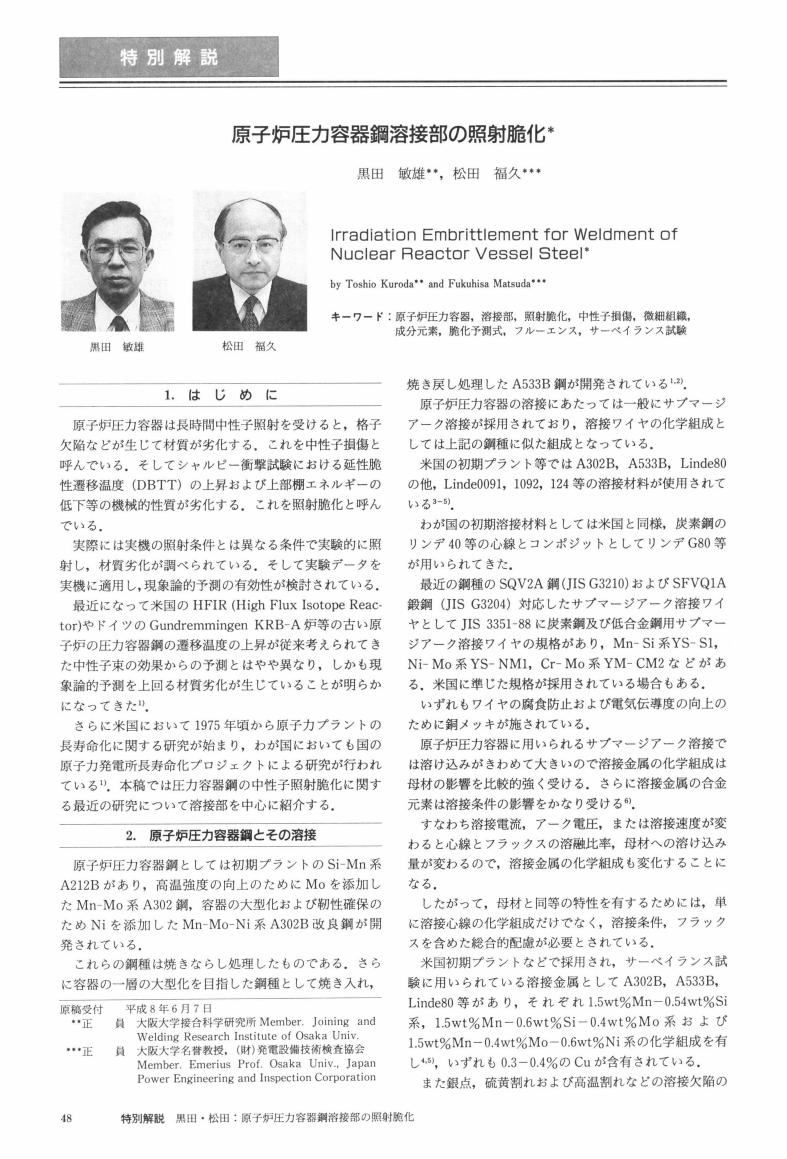1 0 0 0 OA 金属溶接部の微生物腐食
- 著者
- 菊地 靖志 松田 福久
- 出版者
- 社団法人 日本金属学会
- 雑誌
- 日本金属学会会報 (ISSN:00214426)
- 巻号頁・発行日
- vol.32, no.6, pp.393-397, 1993-06-20 (Released:2011-08-10)
- 参考文献数
- 10
- 被引用文献数
- 2 2
1 0 0 0 OA 原子炉圧力容器鋼溶接部の照射脆化
- 著者
- 黒田 敏雄 松田 福久
- 出版者
- 一般社団法人 溶接学会
- 雑誌
- 溶接学会誌 (ISSN:00214787)
- 巻号頁・発行日
- vol.65, no.7, pp.568-575, 1996-10-05 (Released:2011-08-05)
- 参考文献数
- 37
- 被引用文献数
- 1 1
- 著者
- 松田 福久 上山 智之
- 出版者
- 社団法人溶接学会
- 雑誌
- 溶接学会論文集 : quarterly journal of the Japan Welding Society (ISSN:02884771)
- 巻号頁・発行日
- vol.11, no.1, pp.95-101, 1993-02-05
- 被引用文献数
- 6
Solidification crack susceptibility in partially-melted bead-on-plate laser beam weld metal of 6 mm trick 0.2C-1.8Ni-0.55Cr-0.2Mo low alloy steel has been investigated with change of S and P contents in steel using maximum 5 KW CO_2 laser facility beam welder. Effect of weld bead configuration and amount of S and P on crack length in crosssectional bead have been mainly investigated. Estimation of crack length in weld metal was tried by means of regression analysis of data, using bead configuration and impurities of S and P. Moreover, effect of restraint of weld bead during welding on crack susceptibility was investigated. Main results obtained are as follows ; 1) Weld bead configuration is gradually changed from winecup-type to well-type with changing to higher power and higher welding speed in laser beam welding (LBW) within the welding condition in this investigation. 2) With an increase in weld power and welding speed solidification crack susceptibility in weld bead is increased. 3) Solidification cracks have been seen both winecup-and well-type weld bead. However, the cracks were much more in well-type bead than in winecup-type bead in general. 4) S and P impurities in steel have a detrimental effect for the cracks. However, S is 1.8 times more detrimental than P according to statistical investigation. 5) According to statistical investigation the cracks increase with an increase in length of side wall fused and of d_<B1/2> (bead width in 1/2 penetration) 6) The equation which can estimate the crack length in weld bead is introduced from the statistical investigation using the factors of bead configuration and impurities (S, P) in steel. 7) The restraint of the specimen during welding increases the crack susceptibility in weld bead in comparison with the restraint free bead.


